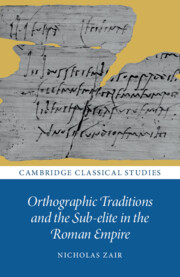Refine search
Actions for selected content:
23990 results in Ancient history
Part II - Making and Breaking Constantine: Julian Augustus
-
- Book:
- Christianity, Philosophy, and Roman Power
- Published online:
- 07 July 2023
- Print publication:
- 01 June 2023, pp 109-206
-
- Chapter
- Export citation
Chapter 2 - Climbing the Ladder
- from Part I - At Constantius’ Court: Julian Caesar
-
- Book:
- Christianity, Philosophy, and Roman Power
- Published online:
- 07 July 2023
- Print publication:
- 01 June 2023, pp 73-108
-
- Chapter
- Export citation
Chapter 1 - How Philosophers Should Take Compliments When They Happen to Become Kings
- from Part I - At Constantius’ Court: Julian Caesar
-
- Book:
- Christianity, Philosophy, and Roman Power
- Published online:
- 07 July 2023
- Print publication:
- 01 June 2023, pp 39-72
-
- Chapter
- Export citation
Epigraph
-
- Book:
- Christianity, Philosophy, and Roman Power
- Published online:
- 07 July 2023
- Print publication:
- 01 June 2023, pp vi-vi
-
- Chapter
- Export citation
Chapter 3 - Holy Hermeneutics
- from Part II - Making and Breaking Constantine: Julian Augustus
-
- Book:
- Christianity, Philosophy, and Roman Power
- Published online:
- 07 July 2023
- Print publication:
- 01 June 2023, pp 111-165
-
- Chapter
- Export citation
Dedication
-
- Book:
- Christianity, Philosophy, and Roman Power
- Published online:
- 07 July 2023
- Print publication:
- 01 June 2023, pp v-v
-
- Chapter
- Export citation
Subject index
-
- Book:
- Christianity, Philosophy, and Roman Power
- Published online:
- 07 July 2023
- Print publication:
- 01 June 2023, pp 345-353
-
- Chapter
- Export citation

Orthographic Traditions and the Sub-elite in the Roman Empire
-
- Published online:
- 25 May 2023
- Print publication:
- 08 June 2023
-
- Book
-
- You have access
- Open access
- Export citation
Index
-
- Book:
- Ancient Greek Housing
- Published online:
- 28 April 2023
- Print publication:
- 25 May 2023, pp 322-330
-
- Chapter
- Export citation
Dedication
-
- Book:
- The Bacchic Gold Tablets and Poetic Tradition
- Published online:
- 11 May 2023
- Print publication:
- 25 May 2023, pp v-vi
-
- Chapter
- Export citation
Chapter 1 - Mapping Memory
-
- Book:
- The Bacchic Gold Tablets and Poetic Tradition
- Published online:
- 11 May 2023
- Print publication:
- 25 May 2023, pp 35-76
-
- Chapter
- Export citation
Chapter 3 - Material Genres
-
- Book:
- The Bacchic Gold Tablets and Poetic Tradition
- Published online:
- 11 May 2023
- Print publication:
- 25 May 2023, pp 107-135
-
- Chapter
- Export citation
Epilogue
-
- Book:
- The Bacchic Gold Tablets and Poetic Tradition
- Published online:
- 11 May 2023
- Print publication:
- 25 May 2023, pp 170-172
-
- Chapter
- Export citation
Preface
-
- Book:
- Ancient Greek Housing
- Published online:
- 28 April 2023
- Print publication:
- 25 May 2023, pp xiii-xvi
-
- Chapter
- Export citation
14 - The Materiality of Numbers
-
- Book:
- The Materiality of Numbers
- Published online:
- 11 May 2023
- Print publication:
- 25 May 2023, pp 340-353
-
- Chapter
- Export citation
6 - Housing, Power and Wealth in Greek Communities during the Late Classical and Early Hellenistic Periods
-
- Book:
- Ancient Greek Housing
- Published online:
- 28 April 2023
- Print publication:
- 25 May 2023, pp 186-216
-
- Chapter
- Export citation
Selection of Ancient Texts in Translation
-
- Book:
- Ancient Greek Housing
- Published online:
- 28 April 2023
- Print publication:
- 25 May 2023, pp 264-269
-
- Chapter
- Export citation
Contents
-
- Book:
- Ancient Greek Housing
- Published online:
- 28 April 2023
- Print publication:
- 25 May 2023, pp v-v
-
- Chapter
- Export citation
Contents
-
- Book:
- The Materiality of Numbers
- Published online:
- 11 May 2023
- Print publication:
- 25 May 2023, pp v-viii
-
- Chapter
- Export citation
2 - Greek Domestic Architecture ca. 950–500 BCE
-
- Book:
- Ancient Greek Housing
- Published online:
- 28 April 2023
- Print publication:
- 25 May 2023, pp 31-65
-
- Chapter
- Export citation
